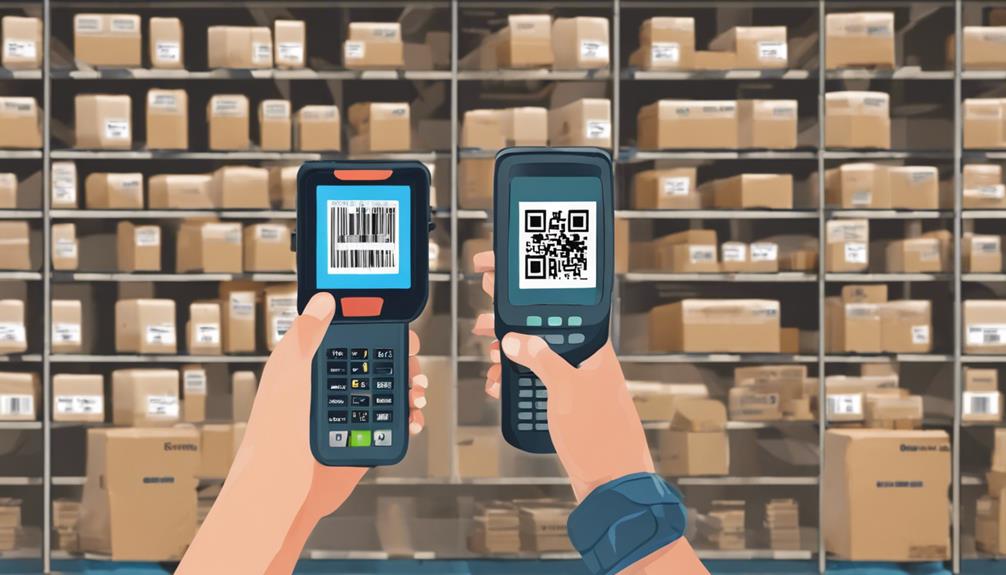With the rise of digital transformation, did you know that 70% of organizations still struggle with document management inefficiencies? Imagine a solution that could revolutionize how you handle your documents. Barcode indexing offers a systematic approach that can transform your document management practices. By exploring the eight ways in which efficient document management can be achieved through barcode indexing, you’ll uncover a world of possibilities to optimize your workflow and boost productivity.
Improved Efficiency Through Barcode Indexing
By implementing barcode indexing in document management systems, organizations can significantly enhance their efficiency. Time savings are a key benefit of this technology. Instead of manually sorting through piles of documents, employees can simply scan the barcode to retrieve the necessary information swiftly. This streamlined process eliminates the need for time-consuming manual searches, allowing employees to focus on more critical tasks.
Furthermore, barcode indexing provides a productivity boost by reducing human error in document organization. With barcodes, documents are accurately labeled and stored in the correct order, minimizing the risk of misplacement or misfiling. This accuracy ensures that information is easily accessible when needed, leading to smoother workflow and increased productivity within the organization. Overall, the combination of time savings and productivity boost offered by barcode indexing equips organizations with the tools they need to operate efficiently and effectively in the digital age.
Cost Benefits of Barcode Indexing
How can barcode indexing impact the bottom line of your organization? Barcode indexing offers significant cost benefits by enhancing efficiency and reducing expenses. By implementing barcode indexing, you can achieve substantial cost savings through streamlined document management processes. The time efficiency gained from barcode indexing allows for quicker document retrieval, reducing labor costs associated with manual searching and filing systems.
Barcode indexing eliminates the need for manual data entry, reducing the likelihood of errors and the costs associated with correcting them. With barcode technology, you can automate data capture and indexing processes, freeing up valuable employee time for more strategic tasks. This increased efficiency translates into cost savings by improving overall productivity and reducing operational expenses.
Error Reduction With Barcode Indexing
When considering error reduction with barcode indexing, it’s crucial to acknowledge the significant benefits it offers in preventing mistakes. Barcodes play a vital role in enhancing accuracy by providing a reliable and efficient way to track and manage documents. Implementing barcode indexing can lead to a notable reduction in errors, ensuring streamlined document management processes.
Error Prevention Benefits
Implementing barcode indexing in document management systems leads to significant error reduction benefits. By utilizing barcodes for indexing documents, you enhance data validation processes. Barcodes ensure that the information entered into the system is accurate and matches the physical document associated with it. This validation step helps prevent errors caused by manual data entry, ensuring that the indexed documents are correctly identified and categorized within the system.
Furthermore, barcode indexing contributes to process optimization by streamlining document retrieval and storage. With barcodes, you can quickly locate and access specific documents, reducing the chances of misplacing or losing important information. The efficiency brought by barcode indexing minimizes the potential for errors that could occur during document handling and management.
Accuracy Enhancement Through Barcodes
To enhance the accuracy of document management processes, the incorporation of barcode indexing proves to be a valuable tool. By assigning unique identifiers to documents, barcodes significantly reduce the margin of error in data entry and retrieval. This accuracy enhancement is crucial for organizations aiming to maintain precise records and streamline operations.
Barcode indexing facilitates workflow optimization by automating tasks that previously relied on manual input. This automation reduces the likelihood of human error, ensuring that documents are accurately labeled and sorted. As a result, productivity enhancement is achieved, as employees can focus on more critical tasks rather than spending time on repetitive data entry processes.
Moreover, the use of barcodes in document management systems minimizes the risk of misfiling or losing important information. This guarantees that documents are easily traceable and accessible when needed, further contributing to accuracy improvement in document handling. Overall, the accuracy enhancement through barcodes leads to more efficient and reliable document management practices.
Barcode Indexing for Large Scale Management
When managing a large volume of documents, barcode indexing offers a streamlined solution for simplifying data retrieval. By implementing barcodes, you can enhance workflow efficiency by quickly locating and organizing documents based on their unique identifiers. This not only improves accuracy but also strengthens the security of sensitive information within a large-scale management system.
Simplifying Data Retrieval
With barcode indexing, the process of simplifying data retrieval for large-scale document management becomes remarkably efficient. By assigning unique barcodes to each document, you can achieve faster retrieval times and a simplified organization structure. When you need to locate a specific document, you can simply scan its barcode and instantly access the relevant information. This eliminates the need for manual searching through numerous files, reducing the time and effort required to find what you need.
Moreover, barcode indexing allows for seamless integration with document management systems, enabling you to categorize and store documents systematically. This not only streamlines the retrieval process but also enhances overall efficiency in managing large volumes of documents. The structured approach provided by barcode indexing ensures that each document is easily identifiable and retrievable, contributing to a more organized and productive workflow. By implementing barcode indexing for data retrieval, you can significantly improve the efficiency of your document management system.
Enhancing Workflow Efficiency
Incorporating barcode indexing into large-scale document management systems revolutionizes workflow efficiency by providing a structured and streamlined approach to organizing and retrieving documents. Barcode indexing allows for rapid identification and categorization of documents, facilitating quick access and retrieval. By assigning unique barcodes to each document, the system can automatically track the location and status of files, reducing the time spent on manual searches and ensuring a more efficient workflow.
Workflow optimization is achieved through the seamless integration of barcode technology, which enables employees to easily scan and locate the required documents. Productivity enhancement is a direct result of this optimization, as tasks that previously consumed valuable time are now completed swiftly and accurately. Employees can focus on more critical aspects of their work, leading to increased efficiency and output.
Improving Accuracy and Security
To enhance the accuracy and security of large-scale document management systems, the implementation of barcode indexing plays a pivotal role. By utilizing barcode technology, you can significantly increase productivity within your organization. Barcode indexing allows for quick and accurate retrieval of documents, reducing the time spent searching for specific files. This streamlined process not only saves time but also enhances overall efficiency in document management tasks.
Moreover, barcode indexing contributes to enhanced compliance with security protocols and regulatory requirements. By assigning unique barcodes to each document, you can track access and modifications, ensuring that sensitive information remains secure and traceable. This level of accountability is crucial for maintaining data integrity and meeting compliance standards in various industries.
Incorporating barcode indexing into your document management system can lead to improved accuracy in data retrieval and storage, ultimately bolstering the security of your documents. This approach not only increases productivity but also ensures enhanced compliance with regulatory guidelines, safeguarding sensitive information effectively.
Security Advantages of Barcode Indexing
By utilizing barcode indexing in your document management system, you can enhance security measures significantly. Barcode indexing offers several security advantages that can help protect your sensitive information effectively:
- Access Control: Implementing barcode indexing allows you to set up access control measures, ensuring that only authorized personnel can retrieve or modify specific documents. This helps prevent unauthorized access and minimizes the risk of data breaches.
- Data Encryption: Barcode indexing systems often come with built-in data encryption features that encode your documents for secure storage and transmission. This encryption makes it difficult for cyber threats to intercept and decipher your information, adding an extra layer of protection to your documents.
- Audit Trails: Barcode indexing systems can create detailed audit trails that track document access, modifications, and other activities. These trails provide visibility into who has interacted with your documents, enabling you to monitor and investigate any suspicious behavior effectively.
Data Retrieval With Barcode Indexing
Enhancing the efficiency of data retrieval processes, barcode indexing simplifies the task of locating and accessing specific documents within your document management system. By assigning unique barcodes to each document, you can ensure faster retrieval times as opposed to manually searching through files. When a document is needed, you simply scan its barcode, allowing the system to quickly locate and retrieve the exact file you require. This streamlined process not only saves time but also reduces the risk of human error in document retrieval.
Furthermore, barcode indexing enhances data organization within your document management system. By categorizing documents with barcodes, you can easily classify and sort them based on specific criteria. This systematic approach makes it easier to retrieve documents based on various parameters such as date, category, or department. As a result, your data becomes more organized and accessible, leading to improved workflow efficiency and overall productivity.
Future of Document Management
As document management evolves in the digital age, the future of organizing and accessing information is set to undergo significant transformations. With the advancement of technology, the landscape of document management is poised for exciting changes that will revolutionize how businesses handle their information.
- Automation Integration: Future document management systems will heavily focus on seamless automation integration to streamline processes, reduce manual tasks, and improve efficiency.
- Future Technology: Emerging technologies like artificial intelligence and machine learning will play a crucial role in shaping the future of document management, offering advanced capabilities for data organization and retrieval.
- Industry Applications and Innovation Trends: Document management solutions will continue to evolve to meet the specific needs of various industries, incorporating innovative trends to enhance security, accessibility, and collaboration within organizations. Keeping pace with these industry-specific applications and innovation trends will be key to staying competitive in the evolving landscape of document management.
Advancements in Barcode Indexing
To enhance document management efficiency and accuracy, advancements in barcode indexing have become instrumental in modern organizational practices. Automation integration plays a crucial role in streamlining operations, allowing for the seamless incorporation of barcode technology into document management systems. By automating the process of indexing documents with barcodes, organizations can significantly improve data organization and retrieval speed. This advancement eliminates the need for manual data entry, reducing the likelihood of human error and enhancing overall data accuracy.
Moreover, process optimization is achieved through barcode indexing advancements, as it allows for the quick and efficient categorization and storage of a vast amount of documents. With the ability to instantly locate specific documents by scanning their barcodes, time-consuming manual searches are eliminated, leading to increased productivity and streamlined operations. Embracing these advancements in barcode indexing technology is essential for organizations looking to enhance their document management practices and achieve higher levels of efficiency and accuracy.
Frequently Asked Questions
How Can Barcode Indexing Integrate With Existing Software Systems?
To integrate barcode indexing with existing systems, customize software to read barcodes. This optimization enhances workflow and boosts productivity. Automate data entry and retrieval processes for efficiency. Embrace the power of barcode indexing in streamlining operations.
Can Barcode Indexing Be Used in Industries Beyond Office Environments?
Yes, barcode indexing is versatile. It efficiently manages warehouse tracking, ensuring accurate inventory. In healthcare, it organizes patient records for quick retrieval. Barcode systems transcend office settings, improving operations in various industries with streamlined data management.
Are There Any Limitations to the Size of Documents That Can Be Indexed?
When it comes to document size for indexing, scalability limitations may arise. However, modern systems have improved accuracy, allowing for efficient handling of large files. Ensure compatibility with your document management system for optimal results.
How Does Barcode Indexing Ensure Data Privacy and Compliance With Regulations?
Barcode indexing enhances data security by providing unique identifiers for documents, limiting access to authorized personnel. It ensures regulatory compliance by tracking document movement and maintaining audit trails. This meticulous system safeguards sensitive information and ensures adherence to legal requirements.
What Are the Maintenance Requirements for Barcode Indexing Systems?
To ensure optimal performance, regular maintenance is essential for barcode indexing systems. System updates should be scheduled periodically to enhance functionality. These practices help uphold efficiency and accuracy, ensuring seamless document management and compliance with regulations.



